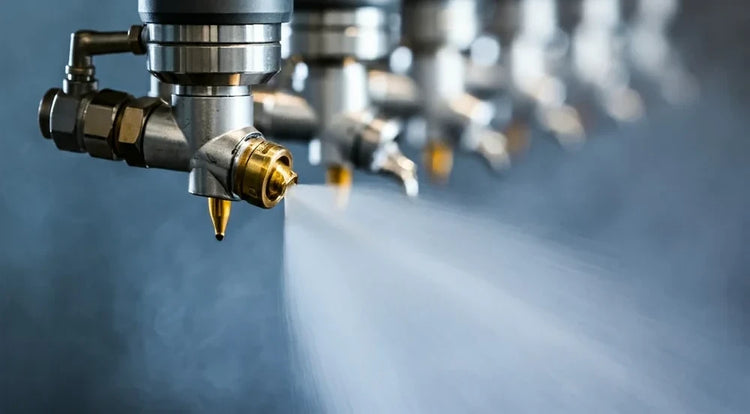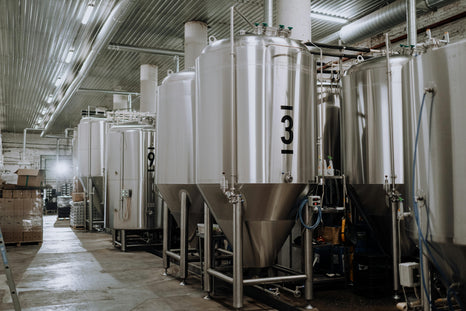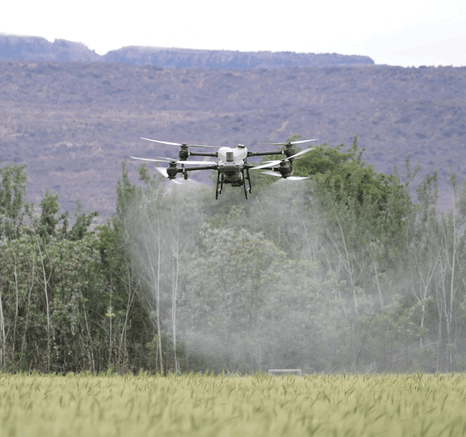Getting the right humidity indoors is pretty important, and a big part of that is the humidification nozzle. This little part helps make sure the air isn't too dry, which can be a problem for all sorts of things, from our health to keeping equipment safe. We're going to look at how these nozzles actually work, what they're used for, and why they matter so much for making inside spaces comfortable and healthy. It's all about getting the air just right.
Key Takeaways
- Humidification nozzles create a fine mist, using either high or low pressure, to put moisture into the air through a process called evaporative cooling.
- These nozzles are used for many things, like keeping indoor humidity at good levels, making air quality better, and helping with specific industrial jobs.
- There are different kinds of humidification nozzle tech, including ultrasonic for very exact control, high-pressure misting for big areas, compressed air for super fine mist, and rotational systems for really large spaces.
- Having the right humidity indoors helps protect sensitive stuff, makes people feel better, and cuts down on static electricity and dust.
- Picking the correct humidification nozzle means looking at what the environment needs, how much pressure the system has, the size of the water drops, and how easy it is to take care of and how long it lasts.
Understanding the Humidification Nozzle
Humidification nozzles are more than just simple sprayers; they're carefully engineered components designed to introduce moisture into the air with precision and efficiency. Understanding how they work and the different types available is key to selecting the right nozzle for your specific needs. At NozzlePro, we get a lot of questions about the basics, so let's break it down.
The Science Behind Mist Creation
The core function of a humidification nozzle is to break down water into tiny droplets, creating a mist that can easily evaporate and increase the humidity of the surrounding air. This process relies on several physical principles, including pressure, surface tension, and fluid dynamics. The size of the droplets is crucial; smaller droplets evaporate faster, leading to more efficient humidification. Nozzles achieve this atomization through various methods, each with its own advantages. The goal is always the same: to maximize the surface area of the water exposed to the air, promoting rapid evaporation.
High-Pressure Versus Low-Pressure Systems
Humidification systems generally fall into two categories: high-pressure and low-pressure. High-pressure systems operate at significantly higher pressures (often above 1000 psi), forcing water through tiny orifices to create a very fine mist. These systems are great for applications needing broad coverage and rapid evaporation, like outdoor cooling or large industrial spaces. Low-pressure systems, on the other hand, operate at lower pressures (typically 70-100 psi) and are better suited for smaller, more localized applications, such as greenhouses or indoor humidification systems. The choice between the two depends on factors like the size of the area to be humidified, the desired humidity level, and energy consumption considerations.
Evaporative Cooling Principles
Evaporative cooling is the process where water absorbs heat from the air as it evaporates. This phase change from liquid to gas requires energy, which is drawn from the surrounding environment, resulting in a drop in temperature. The effectiveness of evaporative cooling depends on the humidity of the air; it works best in dry climates where the air can readily absorb more moisture. In humid environments, the air is already saturated with moisture, so evaporation is slower and the cooling effect is reduced.
Here's a quick look at how different factors affect evaporative cooling:
- Air Temperature: Higher temperatures lead to faster evaporation.
- Humidity: Lower humidity allows for more efficient evaporation.
- Airflow: Increased airflow helps to remove saturated air and bring in drier air, promoting further evaporation.
Understanding these principles is key to optimizing humidifier operation and maximizing the benefits of humidification systems.
Key Applications of the Humidification Nozzle
Humidification nozzles aren't just about making the air feel nicer; they play a vital role in many different settings. From keeping plants healthy to ensuring products are made correctly, these nozzles are surprisingly versatile. Let's take a look at some of the key areas where they make a difference.
Maintaining Optimal Indoor Humidity
The primary function of a humidification nozzle is to maintain a specific level of moisture in the air. This is important in places where humidity levels can fluctuate, causing problems. For example, in museums, too little humidity can damage delicate artifacts. In greenhouses, the right humidity is crucial for plant growth. Humidification systems help prevent these issues by adding moisture to the air as needed.
Enhancing Air Quality and Comfort
Beyond just humidity levels, these nozzles can also improve the overall air quality and comfort of a space. By introducing moisture, they can help reduce dust and other airborne particles, making the air cleaner and easier to breathe. This is especially helpful in dry climates or during the winter months when indoor air tends to be very dry. Proper indoor humidification can make a big difference in how comfortable a building feels.
Specialized Industrial Processes
Humidification nozzles are essential in many industrial processes where precise environmental control is needed. Here are a few examples:
- Printing: Maintaining consistent humidity levels prevents paper from curling or becoming brittle.
- Woodworking: Proper moisture content in the air helps prevent wood from cracking or warping.
- Textile Manufacturing: Humidity control is crucial for preventing static electricity and ensuring the proper handling of fibers.
In these and other industries, even slight variations in humidity can affect product quality and efficiency. Humidification nozzles provide a reliable way to maintain the ideal conditions for these processes.
These nozzles are also used for dust control in mining, construction, and agriculture. By using mist to capture and suppress airborne dust particles, misting nozzles can improve air quality and make the working environment safer for employees. Similarly, misting systems are effective in odor control, as they can trap odor molecules and reduce their spread.
Types of Humidification Nozzle Technologies
Different applications call for different approaches to humidification. The technology behind the nozzle plays a big role in how effectively it can meet those needs. Let's look at some common types.
Ultrasonic Humidification for Precision
Ultrasonic humidifiers use high-frequency sound waves to create a very fine mist. This method is great when you need precise humidity control, like in labs or clean rooms. The mist is so fine that it evaporates quickly and evenly. It's also a quiet way to add moisture to the air. If you're working with sensitive materials or processes, ultrasonic humidification might be the way to go. It's a good choice for environments where consistency is key. Consider these points:
- Extremely fine mist
- Quiet operation
- Precise humidity control
High-Pressure Misting for Broad Coverage
High-pressure misting systems force water through tiny nozzles at high pressure, creating a fine spray that evaporates quickly. This is a good option for larger areas like warehouses or greenhouses. The rapid evaporation provides a noticeable cooling effect, too. High-pressure nozzles are often used outdoors, but they can also be effective indoors when you need to cover a lot of space. It's a simple and effective way to increase humidity and lower the temperature. Here's a quick rundown:
- Effective for large areas
- Provides a cooling effect
- Rapid evaporation
Compressed Air Atomization for Fine Control
Compressed air atomization combines compressed air and water to produce an ultra-fine mist. This method gives you a lot of control over the droplet size and distribution. It's well-suited for applications where you need very consistent environmental conditions, like printing or woodworking. The fine mist evaporates quickly and evenly, preventing water damage. If you need precise control over humidity, compressed air atomization is a solid choice.
Compressed air atomization is particularly useful in environments where maintaining consistent humidity is critical for quality control. The ability to fine-tune the mist characteristics makes it a versatile option for a range of industrial applications.
Rotational Dispersion for Large-Scale Needs
Rotational dispersion uses a rapidly rotating disk to atomize water into fine droplets. A fan then disperses the mist over a large area. This method is robust and reliable, making it a good choice for large-scale industrial applications like manufacturing plants or storage facilities. It's a simple and durable way to maintain consistent humidity over a broad area. Here are some benefits:
- Robust and reliable
- Simple design
- Effective for large areas
Benefits of Proper Indoor Humidification
Proper indoor humidification is more than just a comfort thing; it's a necessity for protecting certain materials and equipment. Think about it: in environments where humidity fluctuates wildly, things like wood can warp, paper can become brittle, and electronics can suffer from static discharge. Maintaining stable humidity levels helps prevent these issues, saving money on repairs and replacements in the long run.
- Prevents warping and cracking of wood products.
- Reduces the risk of damage to paper-based materials.
- Minimizes electrostatic discharge in electronic equipment.
Improving Human Health and Well-being
Beyond protecting objects, proper humidification plays a big role in human health. When the air is too dry, it can lead to dry skin, irritated sinuses, and increased susceptibility to respiratory infections. Optimal humidity helps keep our airways moist, making it easier to breathe and reducing the spread of airborne viruses. It's about creating a healthier, more comfortable environment for everyone. You can use pneumatic atomizing nozzles to achieve this.
Maintaining the right humidity can reduce the spread of airborne viruses, alleviate issues like dry skin and respiratory irritation, and contribute to a healthier and more productive indoor environment.
Reducing Static Electricity and Dust
Static electricity can be a real nuisance, especially in dry environments. It can damage sensitive electronics, cause discomfort, and even pose a fire hazard in certain industrial settings. Similarly, dry air tends to hold more dust, which can worsen allergies and reduce air quality. Proper humidification helps to reduce static electricity and dust levels, creating a cleaner, safer, and more comfortable indoor environment.
Here's a quick look at how humidity affects static and dust:
|
Humidity Level |
Static Electricity |
Dust Levels |
|
Low |
High |
High |
|
Moderate |
Low |
Low |
|
High |
Very Low |
Very Low |
- Reduces static cling in clothing and carpets.
- Minimizes the risk of damage to sensitive electronics.
- Improves indoor air quality by reducing airborne dust particles.
Integrating Humidification Nozzles with HVAC Systems
Integrating humidification nozzles into your existing HVAC (Heating, Ventilation, and Air Conditioning) system can seem complex, but it's a really effective way to improve climate control and efficiency. It's all about finding the right balance and setup for your specific needs. Let's explore how to make it work.
Optimizing Energy Efficiency
One of the biggest benefits of integrating humidification equipment with your HVAC is the potential for energy savings. Properly humidified air feels warmer, which means you might be able to lower your thermostat setting in the winter. This can translate to reduced heating costs. Also, some systems use evaporative cooling, which can lower the temperature using less energy than traditional air conditioning. It's a win-win.
Achieving Consistent Climate Control
Consistent humidity is key for comfort and for protecting certain materials. Integrating humidification nozzles allows for more precise control over the indoor environment. Instead of relying on a standalone humidifier that might only affect a small area, a nozzle system connected to your HVAC can distribute moisture evenly throughout the building. This is especially important in large spaces or buildings with multiple zones. You can target specific areas that need more or less humidity, ensuring a consistent and comfortable environment for everyone.
Reducing Cooling Loads
In warmer months, humidification nozzles can actually help reduce the load on your cooling system. By using evaporative cooling, the nozzles introduce moisture into the air, which then absorbs heat as it evaporates. This process lowers the air temperature, meaning your AC doesn't have to work as hard. This can lead to significant energy savings and extend the lifespan of your cooling equipment. It's like giving your AC a little break, and who doesn't want that?
Integrating humidification nozzles with HVAC systems requires careful planning and consideration of factors like nozzle type, placement, and control systems. However, the benefits of improved energy efficiency, consistent climate control, and reduced cooling loads make it a worthwhile investment for many businesses and homeowners.
Selecting the Right Humidification Nozzle
Okay, so you're in the market for a humidification nozzle. It's not as simple as grabbing the first one you see. You've got to think about what you actually need. Let's break down some key considerations to help you make the right choice.
Assessing Environmental Requirements
First things first: what's the environment like where this nozzle is going? Is it a small, enclosed space, or a massive warehouse? Is it a cleanroom, or a dusty factory floor? The size and nature of the space will heavily influence the type of nozzle you need.
- Consider the existing humidity levels. Are you trying to raise humidity significantly, or just maintain it?
- Think about the temperature. Hotter environments will require more mist to achieve the same humidity level.
- Identify any specific contaminants in the air. Some nozzles are better suited for handling dust or chemicals than others.
Considering System Pressure and Droplet Size
Next up, let's talk pressure and droplet size. These two are closely related and will impact how effectively your humidification system works. High-pressure systems generally produce finer mists, which evaporate more quickly. Low-pressure systems create larger droplets, which can be useful for localized humidification or dust suppression.
|
System Type |
Pressure Range (PSI) |
Droplet Size (Microns) |
Application Examples |
|
Low-Pressure |
10-100 |
50-200 |
Greenhouses, outdoor cooling |
|
High-Pressure |
100-1000+ |
10-50 |
Industrial humidification, cleanrooms |
|
Ultrasonic |
N/A |
1-10 |
Laboratories, specialized industrial processes |
Evaluating Maintenance and Durability
Finally, don't forget about the long game. How easy is this nozzle to maintain? How long is it likely to last? Durability is key, especially in industrial settings where nozzles are constantly in use. Look for nozzles made from robust materials that can withstand the operating conditions.
- Check for features like self-cleaning mechanisms to reduce maintenance downtime.
- Consider the nozzle material. Stainless steel is a good all-around choice, but other materials may be better suited for specific applications.
- Read reviews and ask for recommendations from other users to get a sense of real-world performance.
Choosing the right humidification nozzle is an investment. Taking the time to carefully assess your needs and evaluate your options will pay off in the long run with improved performance, reduced maintenance costs, and a more comfortable and productive environment.
Advanced Humidification Nozzle Features
Humidification nozzles have come a long way! It's not just about spraying water anymore. Modern nozzles are packed with features that make them smarter, more efficient, and easier to maintain. Let's check out some of the coolest advancements.
Smart Control and Automation
Forget manual adjustments. Today's humidification systems can be fully automated. This means you can precisely control humidity levels based on real-time data, adjusting to changes in temperature, occupancy, or even the weather outside. Think of it like a smart thermostat, but for moisture! This is especially useful in industries where consistent humidity is critical, like pharmaceutical manufacturing or data centers. You can even integrate these systems with your existing building management system (BMS) for total control.
Self-Cleaning Mechanisms
Clogging is a common problem with humidification nozzles, especially when dealing with hard water or mineral buildup. Self-cleaning mechanisms are a game-changer. These systems use various methods, such as automated flushing cycles or mechanical cleaning devices, to keep the nozzles clear and operating at peak performance. This reduces maintenance downtime and ensures consistent humidity levels. Here's a quick comparison:
|
Feature |
Traditional Nozzles |
Self-Cleaning Nozzles |
|
Maintenance |
Frequent cleaning |
Reduced cleaning |
|
Clogging Risk |
High |
Low |
|
Water Usage |
Variable |
Optimized |
|
Downtime |
High |
Low |
Corrosion-Resistant Materials
Humid environments can be tough on equipment. That's why using corrosion-resistant materials is so important. Modern humidification nozzles are often made from stainless steel, specialized polymers, or other materials that can withstand constant exposure to moisture and chemicals. This extends the lifespan of the nozzles and reduces the need for frequent replacements. Investing in hydraulic atomizing nozzles made with these materials can save you money in the long run.
Choosing the right materials is key to ensuring the longevity and reliability of your humidification system. Consider the specific environmental conditions and potential chemical exposure when selecting nozzles. This will help you avoid costly repairs and downtime in the future.
Conclusion
So, we've talked a lot about humidification nozzles. It's pretty clear they do a lot more than just spray water around. From keeping things comfy in your home to making sure industrial places run smoothly, these nozzles are a big deal. They help control humidity, which is super important for lots of reasons, like keeping people healthy and protecting sensitive stuff. Knowing how these nozzles work and what they can do helps us make better choices for our indoor spaces. It's all about making sure the air is just right, and these little parts play a huge role in that.












